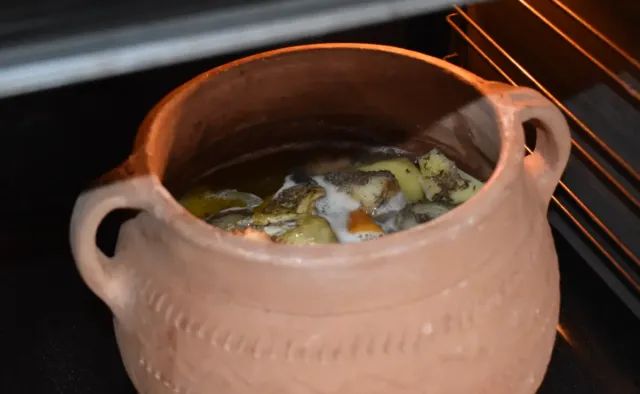Does Food Cooked In Clay Pot Taste Different?
Have you ever noticed a difference in flavor when cooking food in clay pots versus metal or glass cookware? Many home cooks swear by clay pots, claiming they impart a richer, deeper flavor and aroma to soups, stews, rice dishes, and more. So what’s behind this age-old cooking approach that’s recently regained popularity?
Clay pot cooking utilizes unglazed terra cotta clay pots to simmer, braise, and bake foods. Unlike metal and glass which just transfer heat to the food, the porous material of clay pots absorbs and distributes heat in a unique way. This allows for even cooking, enhanced browning via the Maillard reaction, and development of complex flavors. The old-world charm of cooking in traditional clay pottery also appeals to many home cooks today.
In this article, we’ll explore the history of clay pot cooking, how clay pots impact flavor, additional benefits and downsides to consider, tips for cooking with clay pots, and some tempting recipes to try. Read on to learn why cooking in clay may give your food an extra dimension of flavor.
History of Clay Pot Cooking
Clay pots have been used for cooking for thousands of years across many ancient cultures. According to Wikipedia, “Cooking in unglazed clay pots which are first immersed in water dates at least to the Etruscans in first century BC but likely dates to several centuries earlier.” [1]
The earliest known clay pots were crafted by the Sumerians in ancient Mesopotamia around 5,000 BC. The Sumerians utilized clay pots not just for cooking, but also for storage and transport of foods. Over time, clay pot cooking became popular in other ancient cultures like the Greeks, Romans, Chinese, and Indians. Clay pots were prized for their ability to cook food evenly while retaining moisture and nutrients. [2]
Traditionally, clay pots were used for simmering stews, baking breads, cooking rice and legumes, making yogurt, and more. Different cultures developed their own styles of clay pots for optimal cooking utility. For example, Indian tandoor ovens enabled cooking meats and breads at high heat. Chinese clay pots came with tight fitting lids for steaming.
In recent years, there has been renewed interest in clay pot cooking due to potential health benefits and nostalgia for traditional cooking methods. Many cultures are revisiting ancient clay pot recipes and cooking techniques.
How Clay Pots Work
Clay pots work differently than other materials like metal or glass due to the unique properties of clay. Clay is porous and breathable, allowing moisture to evaporate through the sides and top of the pot while retaining heat. The clay material also interacts with food during cooking.
Specifically, clay is made from natural sediments rich in minerals like silica and alumina. When fired at high temperatures, these minerals fuse to form a strong, porous structure [1]. The pores allow steam to escape during cooking which concentrates flavors. At the same time, the thick clay walls retain heat and distribute it gently and evenly to the food.
Additionally, clay is chemically reactive and can absorb substances from food during cooking. Compounds from spices and ingredients get embedded into the clay through this absorption process. This adds more depth of flavor to dishes cooked for a long time in clay pots.
Impact on Flavor
Clay pots have a significant impact on the flavor of food cooked in them. The porous nature of clay allows subtle evaporation and caramelization to occur, enhancing aromatics and taste. As steam from the cooking food escapes through tiny pores in the clay, the liquids reduce and concentrates flavors. Simmering stews and braised meats develop deeper, richer tastes over time in a clay pot.
The evaporation also allows foods to undergo caramelization reactions more readily, leading to the development of complex, toasted flavors on the surface of meats, vegetables, and starches. Studies have shown that the same dishes cooked in metal pots do not develop these rich, caramelized flavors to the same degree.
Additionally, seasonings and spices seem to permeate the food more thoroughly when cooked in clay pots. The permeable clay walls allow the flavors to be absorbed into the dish, rather than remaining only on the surface. This effect leads to food that tastes infused with spices and aromatics from start to finish.
According to food experts, “everything cooked in clay tasted better than the same recipes cooked in metal pans. Rice smelled more floral and absorbed more broth. Braised short ribs fell off the bone after six hours in the oven. And soup stocks were fortified by the minerals leaching out of the clay.” (Food and Wine)
Other Benefits
Cooking with clay pots provides some additional health and efficiency benefits beyond just flavor. According to this source, clay pots add nutrients like calcium, phosphorous, iron, magnesium and sulfur to food. The minerals from the clay leach into the food during the cooking process. This makes clay pot cooking an excellent way to boost the nutritional value of dishes.
Clay pots also have a natural nonstick surface. Foods don’t tend to stick to unglazed clay surfaces. This means you can cook without needing to add much oil or grease. It allows for low-fat cooking while still getting delicious results.
Cooking with clay pots is very energy efficient as well. The clay has good heat retention properties which allows it to cook food evenly at lower temperatures. This can lead to faster cooking times and less energy use compared to other cookware materials like metal.
Downsides to Consider
Clay pots do have some drawbacks to be aware of before cooking with them. The main downsides are the heavy weight and fragility of the material.
Clay pots tend to be heavier than other cookware materials like metal or glass. Their weight makes them more difficult to maneuver while cooking or cleaning. They’re also prone to breaking if dropped due to the brittle nature of fired clay (source: https://www.terracastproducts.com/clay-pots-vs-plastic-pots-better-option-garden-planters/).
Another consideration is that clay pots must be soaked in water before their first use to prevent cracking from thermal shock. The initial prep can be inconvenient compared to other cookware you can use right away.
Finally, clay pots aren’t suitable for all types of cooking. Their porous material can lead to food drying out quickly, so they’re not ideal for dishes requiring longer cook times. Clay also retains heat well, making temperature regulation tricky (source: https://lancaster.unl.edu/choosing-clay-or-plastic-pots-plants).
Tips for Cooking with Clay Pots
When using clay pots, there are some tips to follow for best results:
Soaking and Seasoning
Before their first use, clay pots should be soaked in water for at least 15 minutes to prevent cracking or breaking from too rapid temperature changes. Allow the pot to air dry completely before using. Season the pot by coating the inside with oil and letting it bake in a 350°F oven for 30 minutes before allowing it to cool.
Best Cooking Practices
Clay pots distribute heat slowly and evenly. It’s best to use medium-low heat when cooking to prevent burning. The porous material will absorb liquids while cooking so you may need to add a bit more liquid than with other pots. Stir dishes like rice periodically to prevent sticking.
Cleaning and Care
After cooking, allow clay pots to fully cool before cleaning. Use a soft sponge and mild detergent to clean gently. Avoid abrasive scouring or metal utensils that could scratch the surface. Store clay pots in a dry place when not in use. With proper care, clay pots can last for many years.
Testing Clay Pot Effects

Several scientific studies have examined how clay pots impact flavor compared to other cooking vessels. In one study published in the International Journal of Gastronomy and Food Science, researchers cooked identical chicken thigh recipes in a clay pot and a stainless steel pot. A panel of culinary experts then evaluated the chicken. The results showed the clay pot chicken had a “significantly more tender texture” and was “more aromatic” and “more savory” compared to the stainless steel pot chicken (source).
Amateur cooks have also conducted taste tests at home. Many report that clay pot cooking enhances flavor complexity. For example, one home cook cooked an identical bolognese sauce recipe split between a clay pot and stainless steel pot. They found the clay pot version had a “richer, deeper flavor” while the stainless steel version was “flat” in comparison. However, they noted other factors like simmering time can also impact flavor (source). More amateur testing is needed to draw definitive conclusions.
Recipes to Try
Clay pots are ideal for cooking dishes that benefit from gentle, even heating and moisture retention. Here are some top recipes that are perfectly suited for clay pot cooking:
Chicken Tagine
This classic Moroccan braise features chicken simmered with onions, garlic, spices, and olives in a clay tagine pot. The conical lid traps steam and moisture, resulting in fork-tender meat and robust flavors. Get the recipe from Food & Wine.
Clay Pot Rice
This Chinese comfort food staple involves cooking rice and other ingredients like chicken, Chinese sausage, or mushrooms in a seasoned clay rice pot. The rice develops a lovely crispy crust at the bottom. Check out this clay pot rice recipe.
Römertopf Roast Chicken
This classic German dish is made by placing chicken and vegetables in a Römertopf clay baker, then roasting in a hot oven. The natural moisture retention results in incredibly tender and juicy meat. Get the Römertopf roast chicken recipe.
Conclusion
In summary, using clay pots to cook your food can make a difference in flavor and texture, albeit a subtle one. The porous material allows heat to be dispersed gently and moisture to circulate, resulting in tender, evenly cooked food that retains its natural juices and aromas. The mineral content in the clay can also impart extra traces of aroma and flavor. While not a huge contrast from metal or glass pots, the results from clay are noticeable enough that many cooks prefer using it for stews, rice, beans and other dishes. Just keep in mind that clay pots require some extra care like soaking before first use and gradual heating to prevent cracking. With the right prep and handling, cooking in clay can be an enjoyable way to enhance the flavor of homemade meals.
So in answer to the original question, yes, there is evidence that food cooked in a clay pot does taste slightly different than food cooked in other materials. The porous nature of the clay impacts moisture retention and heat distribution, affecting the final texture and flavor. It’s not a dramatic change, but rather a subtle enhancement that many cooks appreciate.


